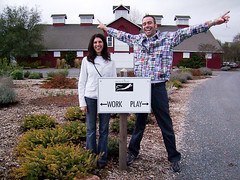The Posture of Being There

My cousin John and his wife Elisa went sightseeing and wine tasting in California over the holidays, and sent snapshots via Snapfish to keep us up to date. This is what we all do ~ connect with each other through pictures. Love it. Though it's more fun in person, I'm thrilled with the technology that lets us share the experience.
Outside of the tech, or perhaps dovetailing with it, is the way the camera works in conjunction with our own bodies. I'm fascinated with the changing posture of photography. The earliest box cameras used by Victorian era shutter bugs to photograph their world (camera held waist level while the neck is craned downward to peer through a cloudy viewfinder) evolved into the Instamatic of last century (camera held up to the eye, neck and back straight), which has given way to today's snappy digitals with live preview, and cell phone cameras (camera held out at arms length or over the head, neck straight and head tilted up slightly to eye the screen on the back of the device). This evolution of body shape and posture -- how does it shape the photo experience?
A question we consider in class - how does viewing the photograph translate back into the body? An example that comes up almost every term is the skyscraper viewed from the ground, parallel lines of glass and steel racing upward, edges converging against clouds or other buildings - do you feel the tension in your neck? Funny, because we're looking at the photograph straight on, seated comfortably in the classroom. But our bodies recall the vertigo of the experience of being there, and the muscles of the neck and back tense in a sympathetic response to the imbalanced posture we would have assumed had we actually been standing on the sidewalk (body stretched back, head craned upward).
This cascade was launched by Elisa's email: "John took most of the pictures and he's pretty good at taking the self-shots since his arms are so long!"
Love it! That's the new posture of photography! And it's precisely right - our modern tech enables us to be outside ourselves in a fundamentally different way than ever before, and to make pictures that prove it. How does this change the activity of photography? How is it massaging our understandings of ourselves, our environment, our connection to others?
I don't know. But I love that lightheaded feeling of stretching my arms out and upward, pointing the camera back at myself, pressing the shutter-release, and then quickly turning the camera around again to check the picture on the screen. It's a bit dizzying, right? And it's almost always surprising to see myself from that disembodied viewpoint that I know I simultaneously did, indeed, embody. It's me and it's not me in a very contemporary way.
But it hadn't occurred to me that some of us are going to have a very different experience of it -- look at that wingspan! John's got the jump on me and my self-photos by a mile. No wonder he always looks so good: those of us with shorter arms are doomed to big heads crowding the frame forever!

A corollary of sorts: last night viewing the inauguration coverage, Obama on stage at one of the evening's parties, the entire lower half of the tv screen was sprinkled with bright blue dots, as if someone had decorated the place with a new type of sparkle, or many strings of Christmas tree lights. I wasn't wearing my glasses so I couldn't quite make out what I was seeing. Then the announcer said (something to effect of) "Never before have so many of any means whatsoever been able to afford some type of photographic device." Of course, those million points of light were digi snaps and cell phone cameras held up at arm's length. I love that he didn't even say the word "camera."
Comments